Feb 8 2018
Ceramic, a kind of poly-crystalline monolith sintered by inorganic, non-metallic crystallites, is typically opaque because of voids, defects, and birefringence. If the inner light scatter is removed, transparent ceramics or optical ceramics would be possible.
 Researchers from Sun Yat-Sen University reported that by slowing down the solvent evaporation rate, metal-organic framework nanocrystals can fuse at room temperature to form transparent ceramic-like monoliths, with optical transmittance up to 84 percent and a low energy threshold for the amplified spontaneous emission. (Image credit: ©Science China Press)
Researchers from Sun Yat-Sen University reported that by slowing down the solvent evaporation rate, metal-organic framework nanocrystals can fuse at room temperature to form transparent ceramic-like monoliths, with optical transmittance up to 84 percent and a low energy threshold for the amplified spontaneous emission. (Image credit: ©Science China Press)
Jie-Peng Zhang and co-workers, from Sun Yat-Sen University, created a new type of material, i.e. metal-organic frameworks, for making optical ceramics. Their work has been recently published as a cover article in Science China Materials, Issue 3 in 2018.
Zhang's team was dedicated to the designing of the metal-organic frameworks and their applications in adsorption, separation, and sensing for a long time. He said, "Optical ceramic belongs to a special type of ceramics, and, like single crystals, it is optically transparent."
Despite the widespread applications in high-performance optical glass and lasing gain medium, the progress of optical ceramic heavily depends on the precursor materials.
To make ceramics transparent, the inner pore and impurity should be minimized to ZERO. This is a very stringent demanding. The precursors not only need high purity and uniform size distribution but also crystallize in the cubic symmetry to remove birefringence effect.
Jie-Peng Zhang
Furthermore, generally, preparing ceramics has to endure high-temperature sintering process. Thus, so far, only a few materials can be used for optical ceramics.
Porous coordination polymers (also referred to as metal-organic frameworks (MOFs)) have captured extensive attention for catalysis, adsorption, sensing and optics. "However, commonly, they are microcrystalline powders." he says, "It is still challenging to prepare MOF membranes and single crystals with high quality and large size."
In spite of low solubility in common solvent, the nanocrystals and building units of MOFs have an outstanding exchange rate, particularly in the grains with small size and large curvature. Zhang highlighted "It is essential to the crystal growth and ion/ligand exchange processes of MOFs." A condensed monolith may be formed by setting right the defects inside the aggregates which are assembled by MOF nanocrystals.
Zhang, as the head of the research group, tells us "This philosophy motivates us to employ MOF nanocrystals as precursors and then make them fused into a transparent monolith, i.e., metal-organic optical ceramics (MOOC)."
The SOD-type zinc(II) 2-methylimidazolate, specifically MAF-4 or ZIF-8, is the first MOF with natural zeolite topology and crystal symmetry, and widely studied for its unusual pore structure and high stability.
Experimentally, we used ethanol as a solvent to produce MAF-4 nanocrystals in diameter of 20 nm, and the gelatinous substance obtained by centrifugation was dried in air at room temperature naturally, which is finally transformed to the colorless and transparent monoliths or MOOC-1, with 84% optical transmittance. If you dry the samples at high temperature and/or in a vacuum, just like general processes in MOF syntheses, you can only obtain the MOF as common white powders.
Jie-Peng Zhang
X-ray diffraction analysis specifies that MOOC-1 is polycrystalline instead of single crystal or glass. The porosities within MOF-4 and its assemblies allow the luminescent dye, sulforhodamine 640 (SRh), to be doped in MOOC-1 to form a luminescent optical ceramic SRh@MOOC-1, which yields amplified spontaneous emission (ASE) with a low energy threshold of 31 micro-Joule per square centimeter stimulated by a 532 nm laser. He emphasizes "This value is lower than previous reports of MOF-based ASE/lasing. "In addition, lowering the solvent evaporation rate is an effective method for fusing MOF nanocrystals into a dense and transparent crystal," Zhang adds.
Prof. Xiao-Ming Chen at Sun-Yat Sen University, the founder of MAF-4, tells us "This strategy extends the candidate scope of optical ceramics and paves a new way to develop MOF-based devices for optical, adsorption, separation and sensing applications."
The National Natural Science Foundation of China funded the research.